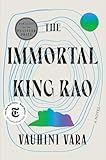Vauhini Vara’s debut story collection, This is Salvaged, features gripping and playful tales about loss, fear, loneliness, and the desire for intimacy. A teenage girl copes with her brother’s death by finding work as a telemarketer, and soon harbors dreams of becoming a phone-sex operator; amid professional and personal setbacks, a woman seeks meaning in an encounter with buffaloes; an artist in the throes of a midlife crisis builds an ark with residents of a Christian shelter after his video pledging to do so goes viral. Vara excels at showcasing the chaotic inner workings of the human mind in the face of crisis. But what I find most remarkable about Vara is how she uses humor and ironic distance to uncover deeper truths about her characters, vulnerabilities they can’t admit, even to themselves.
I spoke with Vara about her approach to the short story form, how humor works in her writing, and the many iterations of This Is Salvaged.
Torsa Ghosal: You published a novel, The Immortal King Rao, prior to this story collection. When you have an idea for a piece of fiction how do you determine if it’s going to be a novel or a short story?
Vauhini Vara: So much of the process of writing, including this aspect of it, remains mysterious to me. It’s true that I conceived of these stories as stories from the start, and that my novel, on the other hand, was conceived of as a novel. But your question has to do with the reasoning behind it, which is what makes it hard to answer, because, for me, the early stages of any piece—and, to be honest, a lot of the stages after that—don’t involve a lot of reasoning. It feels more like being one of those mirrored funhouses and blindly running into walls until I find a way out. That said, with The Immortal King Rao, I did imagine a bigger funhouse from the start. I knew it would include a number of intertwined narrative threads—I imagined telling the story of an entire life, that of King Rao, and not only that, but telling it within its proper socio-historical context—and figured it would take me a long time to get from one side to the other. With stories, it’s more like a couple of funhouse rooms. You can get in and out and not be totally reeling with vertigo.
TG: You wrote the stories in This is Salvaged over several years. At what point did you start to see them as a collection?
VV: I’ve written a lot of stories over the years, and not all of them made it into this collection—and, you’re right, the ones that did make it in are stories I’ve revised over a really long time, in some cases, for 10 or 15 years each. I think over time I started seeing commonalities in the subject matter of my stories: loss; yearning for connection; spirituality and religion; as in my novel, capitalism. At one point I drew a grid, with these themes along the top row and a list of several of my stories in the left-hand column, to make sense of how these themes showed up and progressed. And a sense of an arc started to emerge, a kind of subtle progression of these themes that I could draw out if I assembled the stories in a certain order. So I tried.
That’s the answer having to do with this particular version of this collection. But This is Salvaged had several lives before this. The first life was as my master’s thesis in graduate school; as I understand it, that manuscript, called We Were Here, is sitting in a library somewhere in Iowa City where theses are stored. The second was a version of the collection that my agent tried to sell to publishers eight years ago—also called We Were Here—in which I linked all the stories together, the idea being, to be honest, that linked collections are easier to sell. So, for example, the tortured artist in the title story, “This is Salvaged,” is the father of Sheila, the alcoholic aunt in “I, Buffalo.” One editor read it and was like, “These stories are linked seamlessly.” He was about to buy it and was hoping to make a two-book deal including my novel—but when he read an early draft of my novel, which I guess wasn’t very good yet, he was like, “Oof, never mind.” In the end, the collection didn’t sell.
Then, years later, I took out some stories and added some others—but kept them linked—and sold the collection to my current editor, Alane Mason at W.W. Norton, along with my novel. When she read it, she was like, “This is good, but I don’t know if all the linkages are working for me?” So I unlinked them. And here we are.

TG: I was struck by the diversity of narrative techniques in this collection. How do you decide on the combination of narrative techniques with particular characters, events, and experiences?
VV: As with the first question, this is mysterious, for me, too! Each of these options—character backgrounds, narrative perspective, tense—comes with pros and cons, for sure, but as with a piece of writing ending up as a story or a novel, it’s hard for me to pin down how exactly I decided to take a given approach. While a first-person or close third-person narration written in past tense implies that the main character has some distance on the events at hand—that is, can reflect on them, with some time having passed—a present-tense approach lacks that kind of sense of perspective. And I’m sure that’s why some of my stories involving main characters who are children, for example, are written in the present tense. But that didn’t occur to me till now.
TG: Loss is a recurring theme in the stories. There are deaths of family members in “The Irates” and “The Hormone Hypothesis,” but there are also other kinds of losses, like the erosion of the narrator’s sense of self in “I, Buffalo.” And yet the stories are not about loss per se but what is saved from being completely lost, as the title of your collection also underlines. The stories hold out a promise of salvation, which I would describe as “grace,” if the stories didn’t treat religious notions of deliverance with a bit of skepticism. Where does your interest in salvaging and redemption spring from?
VV: I didn’t write the stories hoping to impart a message, and I’m not religious myself, but, yeah, the religion notion of salvation—the way it comes up in all kinds of religious and spiritual approaches—interests me and moves me, just like it interests and moves a lot of the main characters in these stories. As humans, we’re always trying to figure out what to do with suffering—how to find an “answer” to it, like we’re primed to do, as a species, with all the “problems” we see—and all the characters in these stories are working through that process in their own (sometimes unconventional, sometimes outrageous) ways.
TG: You balance acerbic humor with empathy quite deftly. How do you make sure that the irony doesn’t simply direct judgment against characters’ flaws but also gets at something deeper?
VV: I put humor in my stories because I personally like humor; it’s hard for me to love writing that takes itself too seriously. With respect to judgment, I don’t approach my characters with judgment—I think writing nuanced characters requires that. That said, I’m not sure that I mind if readers judge a particular character harshly or kindly. A Spanish friend who went to Catholic schools, though she isn’t religious, recently read “This is Salvaged,” in which Marlon, the artist, tries to build an ark, and concluded that Marlon represents the Antichrist. I was thrilled by her interpretation, which hadn’t occurred to me before, but which I found brilliant, though I wouldn’t describe Marlon as the Antichrist myself. These characters are made-up—no one is harmed, ultimately, by a reader’s judgment—and part of what I love most about publishing, after having written for so many years without publishing books, is seeing how each reader sort of co-creates a written work with each reading.


























































![President Trump Gives Barron Trump A Shout Out At His Inaugural Party—Barron’s Unexpected Response is Pure Gold! [VIDEO] | The Gateway Pundit President Trump Gives Barron Trump A Shout Out At His Inaugural Party—Barron’s Unexpected Response is Pure Gold! [VIDEO] | The Gateway Pundit](https://www.thegatewaypundit.com/wp-content/uploads/2025/01/barron-trump-crowd-.jpg)